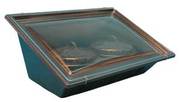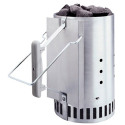Does Memorial Day launch your summer barbecue season? Try these ideas for a barbecue Mother Nature herself would love.
In the Market for a New Grill?

Choose gas or electric. Most grills use either natural gas, propane, charcoal, or electricity. Of these options, charcoal causes the most trouble, emitting more carbon monoxide, particulate matter, and soot than any of the others. If you already use natural gas to heat your home or power your appliances, you may be able to hook up a gas line directly to your grill. The convenience of not needing to refill propane tanks may outweigh the cost of the hook-up. Otherwise, for grilling green choose a propane grill, which burns cleaner than charcoal, or electric. If your energy source is windpower, an electric grill will generate the least pollution of all the options apart from solar.
Still Cooking With Charcoal?
Use lump charcoal instead of briquettes. Briquettes may contain coal dust and other additives. Look for hardwood briquettes from forests certified by the Rainforest Alliance’s SmartWood program, or lumps made from coconut husks. Cow boy Charcoal, sold at Lowe’s, Trader Joe’s and under the Whole Foods 365 brand, makes chunk charcoal out of wood leftover from furniture making and construction.
Trade in your lighter fluid. These toxic petroleum distillates produce volatile organic compounds that 
Try a chimney charcoal starter. Tuck crumpled newspaper or dryer lint into the bottom of the canister, load charcoal on top, and light with a match. You’ll be able to pour hot coals onto the fire grate in about 15 minutes. Alternatively, use an electric starter ($10).












1 thought on “Grilling Green For Healthy Food, Clean Air”
Glad this was helpful!
Comments are closed.